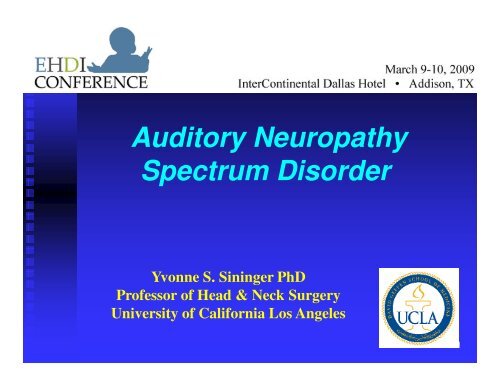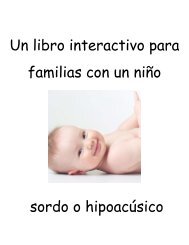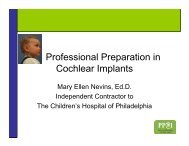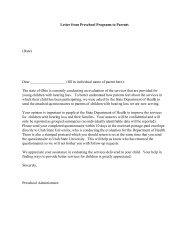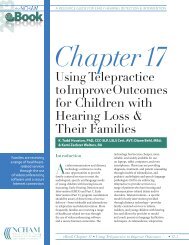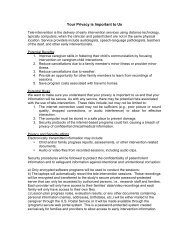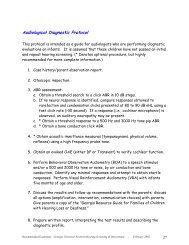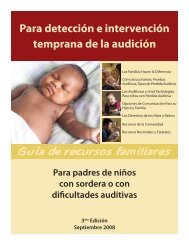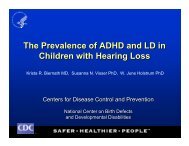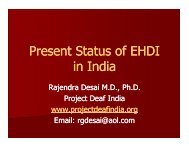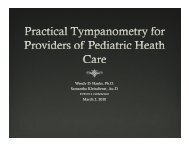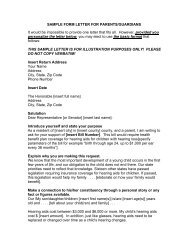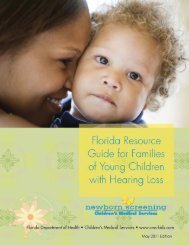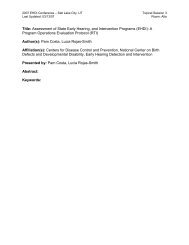Auditory Neuropathy Spectrum Disorder - National Center for ...
Auditory Neuropathy Spectrum Disorder - National Center for ...
Auditory Neuropathy Spectrum Disorder - National Center for ...
Create successful ePaper yourself
Turn your PDF publications into a flip-book with our unique Google optimized e-Paper software.
<strong>Auditory</strong> <strong>Neuropathy</strong><br />
<strong>Spectrum</strong> <strong>Disorder</strong><br />
Yvonne S. Sininger PhD<br />
Professor of Head & Neck Surgery<br />
University of Cali<strong>for</strong>nia Los Angeles<br />
1
Financial Disclosure In<strong>for</strong>mation<br />
I have no relevant financial relationship with the<br />
manufacturers of any commercial products and/or<br />
provider of commercial services discussed in this CME<br />
activity.<br />
I do not intend to discuss an unapproved/investigative<br />
use of a commercial product/device in my presentation.<br />
2
What is it?<br />
Audiologic Signs<br />
• Hearing thresholds from normal to profound<br />
deafness<br />
• <strong>Auditory</strong> Brainstem Response absent or<br />
abnormal.<br />
• Present (prominent) Cochlear Microphonic.<br />
• Otoacoustic Emissions usually present.<br />
• Speech perception poorer than predicted by<br />
audiogram<br />
• Absent middle ear muscle ear reflexes.<br />
3
Count<br />
7<br />
6<br />
5<br />
4<br />
3<br />
2<br />
1<br />
0<br />
<strong>Auditory</strong> <strong>Neuropathy</strong> in Children<br />
< 2 Years of Age<br />
--Mild----Moderate----Severe--Profound<br />
1 0 3 0 5 0 7 0 9 0 1 1 0<br />
P T A<br />
4
dB Hearing Level (ANSI, 1996)<br />
-10<br />
0<br />
10<br />
20<br />
30<br />
40<br />
50<br />
60<br />
70<br />
80<br />
90<br />
100<br />
110<br />
120<br />
COCHLEAR<br />
MICROPHONIC<br />
AUDIOGRAM<br />
250 500 1000 2000 4000 8000<br />
Frequency (Hz)<br />
CZ -> IPSI<br />
CZ -> IPSI<br />
0<br />
5<br />
Female 16 months<br />
10<br />
ms<br />
<strong>Auditory</strong> Brainstem Response<br />
Click 80 dBnHL<br />
15<br />
KC<br />
Rarefaction & Condensation<br />
20<br />
5
PB Max<br />
120<br />
100<br />
Speech Discrimination re PTA<br />
80<br />
60<br />
40<br />
20<br />
0<br />
-20<br />
-20 0 20 40 60 80 100 120<br />
PTA 2 (1000, 2000, 4000 Hz)<br />
<strong>Neuropathy</strong> Speech Discrimination Score<br />
Expected Speech Discrimination Score<br />
6
Potential Sites of Lesion in AN<br />
Based on Symptoms<br />
CM present from either<br />
IHC OHC or both<br />
OAE (outer hair cells)<br />
Functioning<br />
Inner hair cell function<br />
or synapse could be<br />
involved.<br />
ABR Wave I Abnormal Abnormal-<br />
(Peripheral <strong>Auditory</strong><br />
Nerve Involved (?)
Evidence of <strong>Auditory</strong> Nerve<br />
Involvement in <strong>Auditory</strong> <strong>Neuropathy</strong><br />
Starr et al., found 30 30-40% 40% of patients have<br />
evidence of other peripheral nerves disorders<br />
(absent deep tendon reflexes or poor nerve<br />
conduction)<br />
As many as 80% of adult AN patients have subtle<br />
or pronounced peripheral neuropathy (HSMN,<br />
Friedreich’s Ataxia).<br />
Sural nerve biopsy on 4 patients with AN shows<br />
peripheral nerve disease, primarily axonal.<br />
8
Evidence of <strong>Auditory</strong> Nerve<br />
Involvement in <strong>Auditory</strong> <strong>Neuropathy</strong><br />
Human temporal bone histology showing<br />
normal complement of hair cells with poor<br />
ganglion cell survival (Spoendlin, Nadol).<br />
Temporal bone histology on patient with<br />
documented AN shows axonal degeneration<br />
(95% loss of ganglion cells), with a normal<br />
complement of hair cells (30% loss of OHC in<br />
apical turn). Starr et al., Brain 2003<br />
9
Inner Hair Cells from Temporal Bone<br />
of <strong>Auditory</strong> <strong>Neuropathy</strong> Patient<br />
Starr et al., Brain 2003<br />
11
Sedigheh Delmaghani, et al. Nature Genetics 38, (2006)<br />
Mutations in the<br />
gene encoding<br />
pejvakin pejvakin, , a newly<br />
identified protein of<br />
the afferent<br />
auditory pathway,<br />
cause DFNB59<br />
auditory<br />
neuropathy<br />
12
Buchman, CA, Roush, PA, Teagle, HF, et al. (2006).<br />
<strong>Auditory</strong> neuropathy characteristics in children with<br />
cochlear nerve deficiency. Ear and hearing, 27(4), 399 399-408. 408.<br />
Nine (18%) of 51 children with ABR<br />
characteristic of AN have been identified<br />
as having small (N = 2; 4%) or absent (N<br />
= 7; 14%) cochlear nerves on MRI.<br />
RESULTS: Of the nine children with<br />
cochlear nerve deficiency, five (56%)<br />
were affected unilaterally and four (44%)<br />
bilaterally.<br />
13
Rodriguez-Ballesteros M et al (2003) <strong>Auditory</strong> <strong>Neuropathy</strong> in<br />
Patients Carrying Mutations in the Otoferlin Gene (OTOF). Human<br />
Mutation 22:451-456.<br />
<strong>National</strong> Academy of Science<br />
OTOF mutations<br />
can explain 3.5% of<br />
non non- syndromic syndromic<br />
deafness.<br />
Otoferlin involved<br />
in vesicle vesicle-membrane membrane<br />
fusion.<br />
14
Summary of sites of lesion in ANSD<br />
with solid evidence<br />
<strong>Auditory</strong> Nerve<br />
neuropathy or insufficiency<br />
Inner Hair Cell/auditory nerve synapse<br />
15
Consequences of Neural Involvement<br />
• ANSD is known <strong>for</strong> fluctuations in symptoms:<br />
remission, true fluctuations, and/or progression.<br />
• Poor and inconsistent encoding of temporal<br />
in<strong>for</strong>mation lead to unusual temporal processing<br />
and poor speech perception.<br />
• Noise is even more disruptive to auditory/speech<br />
perception than seen in other types of loss.<br />
16
History Factors in <strong>Auditory</strong> <strong>Neuropathy</strong><br />
N=59<br />
(Sininger, Starr & Oba)<br />
3 Dominant Family History<br />
7 Multiple Risk Factors<br />
7 Premature Birth<br />
8 Hyperbillirubinemia<br />
17 Recessive Family History<br />
26 No Known Risk Factors<br />
17
Management of Children with ANSD<br />
28%<br />
Assistive Listening Devices<br />
N = 140<br />
31%<br />
35%<br />
6%<br />
CI (49)<br />
CI + HA (8)<br />
HA (44)<br />
NAD (39)<br />
From Pat Roush U. North Carolina<br />
Complicated by difficulty in audiometrics<br />
18
Half of Subjects with Hearing Aids<br />
show significant improvement.<br />
Rance et al., E&H 2002<br />
19
T and C Levels and NRT Thresholds are the Same <strong>for</strong><br />
AN Patients and Controls<br />
Peterson, Shallop, et al al.<br />
20
Electrical stimulation “reintroduces” timing precision<br />
and synchrony, demonstrated in an electrical ABR<br />
Peterson, Shallop, et al al.<br />
21
UNC AN Children with CI N=49<br />
35%<br />
15%<br />
CI in AN EAR<br />
21%<br />
29%<br />
From Pat Roush U. North Carolina<br />
2 yrs of use)<br />
N=13<br />
Limited Open Set (
Rehabilitation Strategies <strong>for</strong><br />
Children with ANSD<br />
Significant individual variability is seen across<br />
patients.<br />
Rehabilitation strategy may need to incorporate<br />
and emphasize visual in<strong>for</strong>mation.<br />
Delays in obtaining audiometric in<strong>for</strong>mation is<br />
common.<br />
Persistent, frequent monitoring of hearing and<br />
communication ability is recommended.<br />
23
Thanks <strong>for</strong> Listening<br />
24


